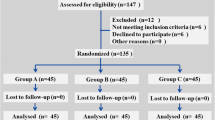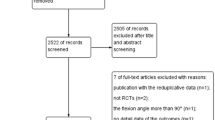Abstract
Purpose
A consistent post-operative limb positioning regime could be an attractive, simple and cost-effective alternative to improve patient’s outcomes after total knee arthroplasty (TKA). The aim of this study was to perform a systematic review of the available literature in order to understand whether a consistent post-operative limb positioning regime could affect blood loss and range of motion (ROM) after TKA.
Methods
A search was performed using the keywords “total knee replacement/knee prosthesis” in combination with “post-operative management”, “blood loss”, “range of motion”, “leg position”, “flexion”, “extension” and “splinting” regardless of the year of publication. The scientific databases have been accessed in order to identify papers dealing with post-operative limb positioning regimes after TKA.
Results
Seven articles matching the inclusion criteria were selected. Blood loss and ROM were both investigated in all but one paper, in which only blood loss was evaluated. There were six randomized controlled trials and one prospective comparative study. A 48–72 h post-operative knee flexion protocol seems to be effective in reducing blood loss and increasing ROM following TKA. We did also find no benefit in using extension splints in the immediate post-operative period.
Conclusions
Based on the studies undertaken to date, a 48–72 h post-operative knee flexion protocol should be implemented as an easy and inexpensive method of reducing blood loss and increasing ROM following TKA. Shorter flexion regimes failed to influence these parameters.
Level of evidence
II.


Similar content being viewed by others
References
Carson JL, Duff A, Poses RM, Berlin JA, Spence RK, Trout R, Noveck H, Strom BL (1996) Effect of anaemia and cardiovascular disease on surgical mortality and morbidity. Lancet 348(9034):1055–1060
Dennis DA, Heekin RD, Clark CR, Murphy JA, O’Dell TL, Dwyer KA (2013) Effect of implant design on knee flexion. J Arthroplast 28(3):429–438
Fickert S, Jawhar A, Sunil P, Scharf H-P (2012) Precision of Ci-navigated extension and flexion gap balancing in total knee arthroplasty and analysis of potential predictive variables. Arch Orthop Trauma Surg 132:565–574
Fu Y, Wang M, Liu Y, Fu Q (2012) Alignment outcomes in navigated total knee arthroplasty: a meta-analysis. Knee Surg Sports Traumatol Arthrosc 20:1075–1082
Gillette BP, DeSimone LJ, Trousdale RT, Pagnano MW, Sierra RJ (2013) Low risk of thromboembolic complications with tranexamic acid after primary total hip and knee arthroplasty. Clin Orthop Relat Res 471:150–154
Gross JB (1983) Estimating allowable blood loss: corrected for dilution. Anesthesiology 58(3):277–280
Den Hertog A, Gliesche K, Timm J, Mühlbauer B, Zebrowski S (2012) Pathway-controlled fast-track rehabilitation after total knee arthroplasty: a randomized prospective clinical study evaluating the recovery pattern, drug consumption, and length of stay. Arch Orthop Trauma Surg 132(8):1153–1163
Hewitt B, Shakespeare D (2001) Flexion vs. extension: a comparison of post-operative total knee arthroplasty mobilisation regimes. Knee 8(4):305–309
Horton TC, Jackson R, Mohan N, Hambidge JE (2002) Is routine splintage following primary total knee replacement necessary? A prospective randomised trial. Knee 9(3):229–231
Husted H, Holm G, Jacobsen S (2008) Predictors of length of stay and patient satisfaction after hip and knee replacement surgery: fast-track experience in 712 patients. Acta Orthop 79(2):168–173
Jergesen HE, Poss R, Sledge CB (1978) Bilateral total hip and knee replacement in adults with rheumatoid arthritis: an evaluation of function. Clin Orthop Relat Res 137:120–128
Johnson DP (1993) Infection after knee arthroplasty. Clinical studies of skin hypoxia and wound healing. Acta Orthop Scand Suppl 252:1–48
Kurtz S, Ong K, Lau E, Mowat F, Halpern M (2007) Projections of primary and revision hip and knee arthroplasty in the United States from 2005 to 2030. J Bone Joint Surg Am 89(4):780–785
Li B, Wen Y, Liu D, Tian L (2012) The effect of knee position on blood loss and range of motion following total knee arthroplasty. Knee Surg Sports Traumatol Arthrosc 20(3):594–599
Li B, Wen Y, Wu H, Qian Q, Lin X, Zhao H (2009) The effect of tourniquet use on hidden blood loss in total knee arthroplasty. Int Orthop 33(5):1263–1268
Liebensteiner MC, Krismer M, Koller A, Semenitz B, Mayr E (2012) Does minimally invasive total knee arthroplasty improve isokinetic torque? Clin Orthop Relat Res 470(11):3233–3239
Lin P-C, Hsu C-H, Huang C-C, Chen W-S, Wang J-W (2012) The blood-saving effect of tranexamic acid in minimally invasive total knee replacement: is an additional pre-operative injection effective? J Bone Joint Surg Br 94(7):932–936
Losina E, Thornhill TS, Rome BN, Wright J, Katz JN (2012) The dramatic increase in total knee replacement utilization rates in the United States cannot be fully explained by growth in population size and the obesity epidemic. J Bone Joint Surg Am 94(3):201–207
Ma T, Khan RJK, Carey Smith R, Nivbrant B, Wood DJ (2008) Effect of flexion/extension splintage post total knee arthroplasty on blood loss and range of motion—a randomised controlled trial. Knee 15(1):15–19
Madarevic T, Tudor A, Sestan B, Santic V, Gulan G, Prpic T, Ruzic L (2011) Postoperative blood loss management in total knee arthroplasty: a comparison of four different methods. Knee Surg Sports Traumatol Arthrosc 19(6):955–959
Maniar RN, Baviskar JV, Singhi T, Rathi SS (2012) To use or not to use continuous passive motion post-total knee arthroplasty presenting functional assessment results in early recovery. J Arthroplast 27(2):193–200
Muñoz M, Ariza D, Garcerán MJ, Gómez A, Campos A (2005) Benefits of postoperative shed blood reinfusion in patients undergoing unilateral total knee replacement. Arch Orthop Trauma Surg 125(6):385–389
Ong SM, Taylor GJSC (2003) Can knee position save blood following total knee replacement? Knee 10(1):81–85
Raut S, Mertes SC, Muniz-Terrera G, Khanduja V (2012) Factors associated with prolonged length of stay following a total knee replacement in patients aged over 75. Int Orthop 36(8):1601–1608
Roy SP, Tanki UF, Dutta A, Jain SK, Nagi ON (2012) Efficacy of intra-articular tranexamic acid in blood loss reduction following primary unilateral total knee arthroplasty. Knee Surg Sports Traumatol Arthrosc 20(12):2494–2501
Schröder D, Pässler HH (1994) Combination of cold and compression after knee surgery. A prospective randomized study. Knee Surg Sports Traumatol Arthrosc 2(3):158–165
Voorn VMA, Marang-van de Mheen PJ, So-Osman C, Vlieland TPMV, Koopman-van Gemert AWMM, Nelissen RGHH, van Bodegom-Vos L, LISBOA Study Group, Brand A, Engberts DP, van der Hout WB, Kaptein AA, van Mourik JBA (2012) Designing a strategy to implement cost-effective blood transfusion management in elective hip and knee arthroplasties: a study protocol. Implement Sci 7:58
Watts CD, Pagnano MW (2012) Minimising blood loss and transfusion in contemporary hip and knee arthroplasty. J Bone Joint Surg Br 94(11 suppl A):8–10
Wegrzyn J, Parratte S, Coleman-Wood K, Kaufman KR, Pagnano MW (2013) The John Insall award: no benefit of minimally invasive TKA on gait and strength outcomes: a randomized controlled trial. Clin Orthop Relat Res 471:46–55
Weinstein AM, Rome BN, Reichmann WM, Collins JE, Burbine SA, Thornhill TS, Wright J, Katz JN, Losina E (2013) Estimating the burden of total knee replacement in the United States. J Bone Joint Surg Am 95(5):385–392
Yang Z-G, Chen W-P, Wu L-D (2012) Effectiveness and safety of tranexamic acid in reducing blood loss in total knee arthroplasty: a meta-analysis. J Bone Joint Surg Am 94(13):1153–1159
Al-Zahid S, Davies AP (2012) Closed suction drains, reinfusion drains or no drains in primary total knee replacement? Ann R Coll Surg Engl 94(5):347–350
Zenios M, Wykes P, Johnson DS, Clayson AD, Kay P (2002) The use of knee splints after total knee replacements. Knee 9(3):225–228
Conflict of interest
The authors declare that they have no conflict of interest.
Author information
Authors and Affiliations
Corresponding author
Rights and permissions
About this article
Cite this article
Faldini, C., Traina, F., De Fine, M. et al. Post-operative limb position can influence blood loss and range of motion after total knee arthroplasty: a systematic review. Knee Surg Sports Traumatol Arthrosc 23, 852–859 (2015). https://doi.org/10.1007/s00167-013-2732-4
Received:
Accepted:
Published:
Issue Date:
DOI: https://doi.org/10.1007/s00167-013-2732-4




